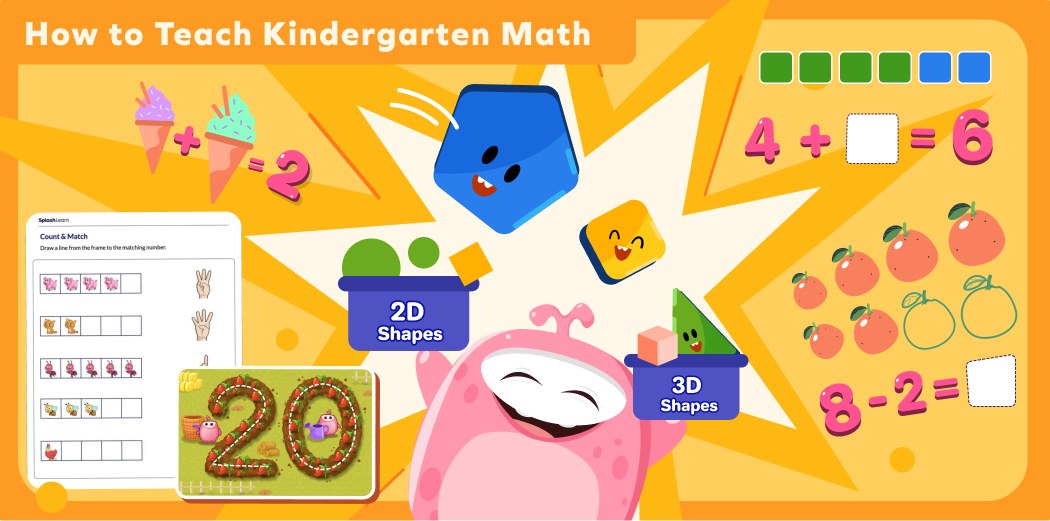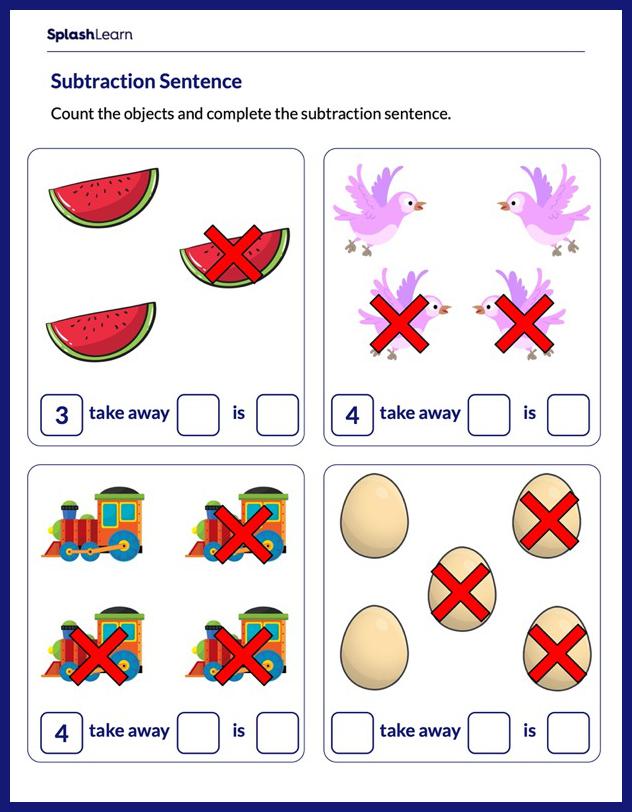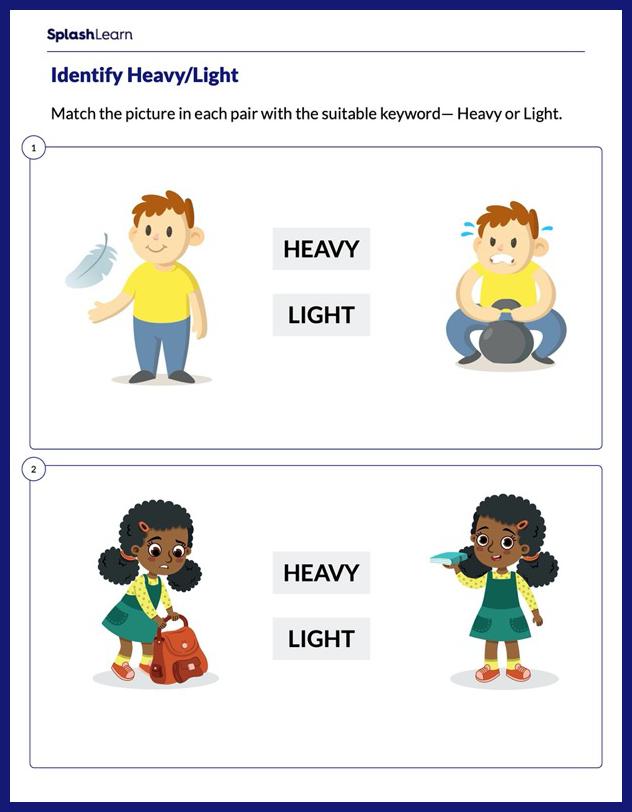Wondering how to teach kindergarten math? It is often mistaken as something anyone can easily prepare and teach. It’s maybe because skills seem basic at a glance.
Imagine a classroom filled with students at different stages of learning—some kids are counting with ease, while others are learning to hold a pencil. Teaching kindergarten math skills involves considerable preparation. There’s rarely a break, so you need to think on your feet and have a variety of activities ready in your pocket to keep little ones happy and engaged!
Math & ELA | PreK To Grade 5
Kids see fun.
You see real learning outcomes.
Watch your kids fall in love with math & reading through our scientifically designed curriculum.
Parents, try for free Teachers, use for free
This guide is designed to support you every step of the way, whether you’re a kindergarten teacher or a parent, offering a clear breakdown of what kindergarteners learn in math, common challenges, and effective teaching strategies to build a classroom of self-starters. Plus, find a wealth of FREE resources for teachers, including:
How to Teach Kindergarten Math
Let’s dive into important kindergarten math topics and explore how to teach kindergarten math in a fun and engaging way!
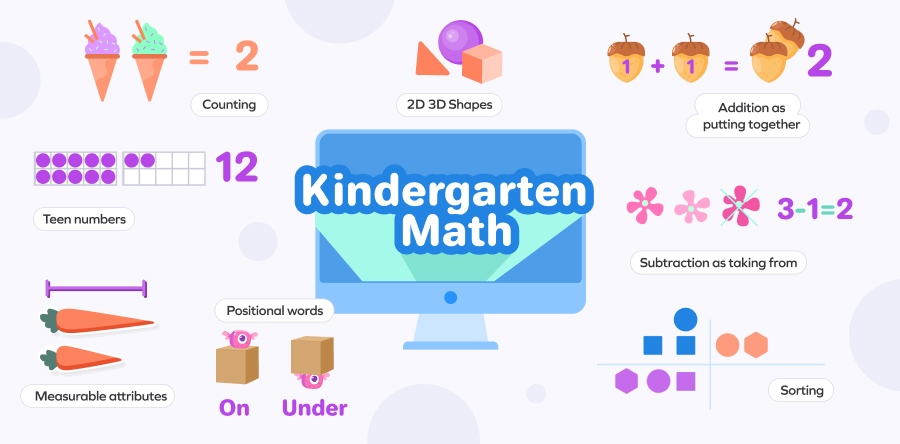
1. Number Recognition, Counting, and Comparing Numbers
| Number Sense in Kindergarten | |
|---|---|
| Number names and counting sequence | • Count to 100 by ones and tens • Count forward from any given number within the sequence. • Write and represent numbers from 0 to 20 |
| Counting to tell the total number of objects. | • Understand one-to-one correspondence. • Understand that i) the last number you count tells the total number of objects, regardless of arrangement or order, ii) each successive number is “one more” than the given number. • Count up to 20 objects in a line, a rectangular array, or a circle. • Count up to 10 things in a scattered configuration. |
| Comparing numbers | • Compare groups of objects (using matching, counting, observation, and benchmarks). • Compare two written numerals between 1 and 10. |
When math is taught in kindergarten classrooms, more instructional time is dedicated to learning numbers and cardinality. Number sense isn’t something you can simply pour into a student’s mind. It’s that inherent and intuitive understanding of numbers developed through experiences!
Remember: little ones thrive on the “learning by doing” approach. Include fun activities and educational games in your daily math centers or lesson warm-ups, such as:
- Counting lots of things up to 20 (stairs, chairs, marbles, and more!)
- Matching and comparing numbers to groups of things.
- Writing numbers to show how many things they counted.
Subitizing is another crucial part of kindergarten math concepts—an ability to recognize the number of objects using patterns without counting (e.g., looking at 8 objects as 5 and 3). Here are some games to boost subitizing skills:
With some planning, fun resources, and hands-on activities, you can make learning numbers a joy for you and your classroom! Building on this understanding and inspired by teachers’ advice on what effectively works with 5-6-year-olds, we have created a fun collection of ready-to-deliver and FREE lesson plans for teachers.
It may not be an easy ride, but walking into the classroom a little prepared gives a confidence boost (you know this feeling!). Here are some common challenges students might encounter with numbers and counting:
| Common challenges | Here’s a quick teaching tip! |
|---|---|
| Confusing similar-looking numbers like 6 and 9. | Consider using number recognition games for kindergarten during computer centers. By matching number cards up to 20, kids will get plenty of practice and soon be able to easily distinguish between shapes of tricky numbers. |
| Difficulty associating number symbols with number names or quantities. | Use number tracing worksheets for kindergarten as fun homework! Have kids trace both the numerical and word forms of numbers. |
| Counting the same set of objects wrong after rearrangement (not understanding the conservation of cardinality principle) | This counting objects in multiple arrangements game will work perfectly as a short two-group activity in math workshops. |
| Confusing number order; skipping or repeating numbers when counting; not able to count up to a certain number | Use rhymes! Try Let’s Make the Number Song 1-10 Game as your game hour activity! Parents can play this YouTube video, Fun Number Song 1-20, at home and sing along with their kids. |
Combine number sense practice and assessment in one easy-to-use resource with printable fun worksheets! These printables feature pictures, visuals, and engaging layouts that keep kids excited while reinforcing essential numerical skills.
Bonus Tips:
- Try this online Counting Numbers Teaching Tool. It’s free to use and perfect for demonstrating one-to-one correspondence. Drag objects (birds, counters, and more!) into a box and let your class count with you!
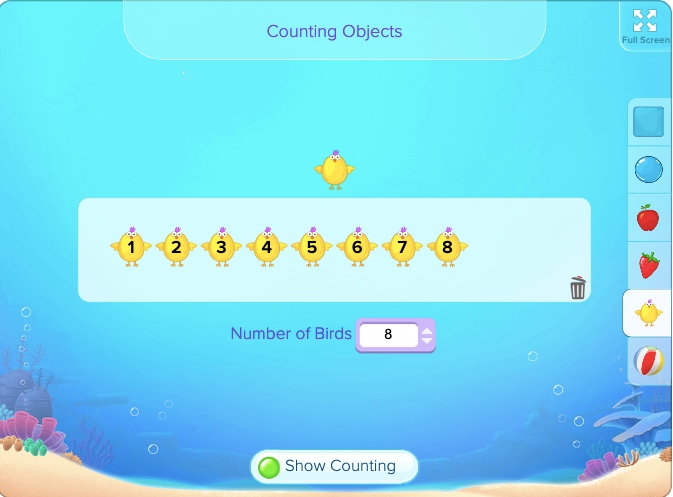
- Many teachers love using manipulatives like blocks, counters, and beads in class. Allow children to touch and move objects as they count, sort, add, and subtract. This hands-on teaching method is also effective because it involves kids’ direct participation.
Related Reading: Best Number Activities for Preschoolers
2. Addition and Subtraction
| Addition and Subtraction in Kindergarten | |
|---|---|
| Understand addition as putting together (combining) and adding more to a set of things.Understand subtraction as taking apart and taking away. | • Represent addition and subtraction visually (using objects, sounds, verbal cues, expressions, or equations.) • Visualize and solve addition and subtraction word problems within 10. • Break down numbers up to 10 in different ways • Identify number pairs from 1 to 9 that make 10. • Fluently add and subtract within 5. |
NOTE: In kindergarten, the following types of addition and subtraction problems are taught: add to (result unknown), take from (result unknown), and put together/take apart (total unknown or both addends unknown).
A teacher once humorously shared that teaching addition and subtraction to kindergarteners feels like explaining taxes to adults! This highlights how teaching basic math to little ones can be challenging, considering the diverse learning styles, varying skill levels, and unique challenges each kid brings to the classroom. Let’s simplify this.
- These concepts can be abstract for kids. Sitting them down with pencils and notebooks will not work. Asking them to memorize addition and subtraction facts will not work either.
- Help them see it before they solve it! Kindergarten is the perfect time to start teaching kids how to think in math language!
- Use direct modeling strategies, such as counting all, counting on, counting back, doubles, taking away, fact families, and more.
- Encourage kids to think about the logic behind addition and subtraction. Instead of just making them add and subtract numbers, teach them what these operations truly represent.
The goal is to help kids achieve math fact fluency—accuracy, speed, and confidence! Instead of solely focusing on “right” answers, celebrate students who are “almost” there! If you are having an idea block, that’s totally normal! Try our Addition and Subtraction Lesson Plans for Kindergarteners. They will supercharge your lessons!
| Common challenges | Here’s a quick teaching tip! |
|---|---|
| Struggling to find missing addends (problems like 15 – __ = 9) | Play Find the Missing Number in Addition Game or Find Missing Numbers in Subtraction Sentences Game as a quick, engaging review warm-up activity in your class! Include students in the thinking process at every step. |
| Trouble translating or visualizing word problems into addition or subtraction expression | Start your math block with Addition Word Problems Games for Kindergarten and Subtraction Word Problems for Kindergarten! Discuss 1-2 problems daily in your classroom routine. |
| Confusion about applying the same skill with a different strategy | Encourage kids to choose a strategy and collaborate in groups. These games can be helpful: Addition strategies games for kindergarteners and subtraction strategies games for kindergarteners. Rotate the games regularly! |
Help kids visualize abstract concepts like “putting things together” and “taking objects away.” Learning games build confidence and motivate kids to learn through powerful animations and quick feedback! Try interactive online addition games and subtraction games as reinforcement tools in your kindergarten classroom.
Supervised practice is key to mastering addition and subtraction—no instant magic fix exists. These printables are crafted to provide the extra support kids need to develop these essential math skills.
Bonus Tips:
- This Hundreds Chart Teaching Tool is a free tool for teachers. Use colors to highlight or hide numbers. By counting forward or backward, show kids what “adding 2 more” or “taking 4 away” looks like.
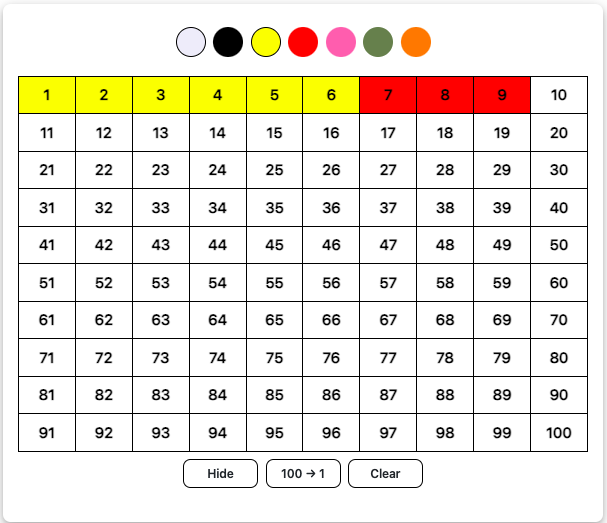
- Math facts practice: This tool is perfect for online practice. Here are some fantastic features:
- Completely FREE for teachers!
- Choose your preferred operator (addition or subtraction).
- Pick a number range (up to 20).
- Select answer type: MCQ or type-in.
- Add a timer for an extra challenge!
- Using Fingers and Toes: Kids tend to pick this method naturally! Add numbers by putting your fingers up. Show subtraction by putting your fingers down. It’s a simple and intuitive technique.
- Addition and Subtraction with Snacks: Kids love snacks! Use small crackers or fruit pieces to teach adding and taking away.
- Real-World Story Problems: Learning addition and subtraction through real-life situations is super effective! Use various real-life themes (such as cooking or sports) and help kids visualize story problems.
3. Teen Numbers (Place Value Foundation)
| Teen Numbers in Kindergarten | |
|---|---|
| Explore numbers 11-19 to build a basic understanding of place value. | Compose (build) and decompose (break apart) numbers from 11 to 19 into ten and some further ones, by • Using objects or drawings. • Recording each composition or decomposition by a drawing or expression. • Understanding that these numbers are composed of ten ones and a few more (1-9) ones. |
Moving from counting up to 10 to mastering numbers 11–19 can seem daunting for kids. However, think of it as building upon their existing counting skills.
- Teach “eleven and twelve” separately as unique number names. Create an anchor chart with the numbers 11 and 12 prominently displayed in your classroom anchor charts or bulletin boards. Visual reminders help!
- Use place value cards, number bond drawings, and 10-frames to teach teen numbers as—10 and some more. (Idea: Use the CLAPPING method to show the transition from 10s to leftovers: Count to 10, clap together, and count the leftovers.)
Here are interactive lessons designed to introduce teen numbers to kindergarteners in creative ways (find everything from lesson intro to exit ticket questions):
| Common challenges | Here’s a quick tip! |
|---|---|
| Moving from single digits to teen numbers can be challenging. Also, understanding the idea of “10 and some more” can confuse kids. | Let kids group objects (in numbers 10-20) in groups of 10. After each round, ask about leftovers. Use Teen Numbers Games for Kindergarteners as an at-home learning activity. It explains how a filled ten-frame or a rod represents 10 ones. |
Once kids are comfortable with teen numbers, you can assess their understanding to identify areas where they might need extra support. These printables are perfect for the job (you can use them to create task cards or small solve-it-strips):
4. Measurement, Classifying Objects, and Sorting
| Measurement and Sorting in Kindergarten | |
|---|---|
| Describe and compare measurements. | • Describe the measurable attributes of objects, such as length, height, capacity, or weight. • Compare two objects by measuring a shared attribute to determine which has more or less of it, and describe how they differ. |
| Classify objects and count the number of objects in each category. | • Group objects into specified categories, count them category-wise and then order the categories based on those counts. |
Let’s first focus on preparing effective measurement lessons for kindergarten.
- Remember, visual aids are essential. Let kids see, touch, and interact with various objects. This hands-on approach helps them understand and internalize the concept of measurements.
- Encourage them to engage with materials actively—they can learn a lot just by exploring and comparing different objects!
- To help kids practice measurement concepts independently, provide them with a scaffolded learning experience at home. Include worksheets designed to gradually increase in difficulty, and plan partner activities in centers that offer initial guidance before transitioning to more independent practice.
Now, let’s talk about how to teach sorting to kindergarteners.
- The idea is to make sorting FUN through playful activities! It’s all about allowing kids to figure it out on their own.
- Help them organize objects by color, size, type, and name. This way, they see sorting in action and understand it better while having a blast!
- Engage kids in interactive sorting games! It’s a fun way to teach kids about categories using everyday objects, such as flowers and birds. Visual cues help them easily understand sorting!
It becomes more intuitive with regular practice. Consider using Data Handling Worksheets for Kindergarteners as homework assignments! Parents can easily guide kids through these activities.
| Common challenges | Here’s a quick teaching tip! |
|---|---|
| Using the incorrect vocabulary when comparing measurements | Kids observe, kids listen, and kids learn. Use comparison words intentionally around them.How about using Measurement Games for Kindergarteners as a 3-5 minute interactive session with kids? |
| Deciding what makes objects belong in the same group (defining data categories), mainly if multiple relevant attributes exist | Teach them to prioritize and focus on one attribute at a time. Include Sorting Objects Games for Kindergarteners as a fun cool-down activity at the end of the day! |
Bonus Tips:
- Sorting Household Items by Size or Use: Gather various household items and have the children sort them. This activity not only teaches sorting but also boosts vocabulary and helps children understand the functions of different objects. For example:
- By Size: Sort items into “big” and “small” groups.
- By Use: Group items into categories like “things to eat with” and “things to write with.”
- Classifying and Sorting Nature Finds: Connect learning to nature outside by collecting leaves, rocks, or sticks. Then, have the kids sort their finds:
- By Texture: Group items into “smooth” and “rough.”
- By Size: Sort objects into “large” and “small.”
- By Color: Arrange finds by color shades.
Related Reading: Best Hands-On Measurement Activities for Kids
5. Identifying 2D and 3D Shapes
| 2D and 3D Shapes in Kindergarten | |
|---|---|
| Identify and describe 2D and 3D shapes. | • Describe real-life objects by their shapes. Describe their relative positions using positional words such as above, below, beside, in front of, behind, and next to. • Name shapes correctly, no matter their orientation or size. • Categorize shapes as 2D (flat) or 3D (solid). |
| Analyze, compare, create, and compose shapes. | • Analyze and compare 2D and 3D shapes of various sizes and orientations, informally discussing their similarities, differences, and other attributes. • Create models of real-world shapes using materials like sticks and clay, and draw shapes. • Combine simple shapes to create larger ones. |
Last but not least, a crucial part of kindergarten math concepts is exploring SHAPES! Here are some tips to consider:
- Textbook drills will not do. We can’t simply direct kids to turn to page 5 and read the location words. They need to hear, say, and use these words. (IDEA: Hide a toy and give clues using these words. e.g., The toy is under the table, near the green book, or inside the box.)
- Make learning positional words fun with interactive online games! Picture-based animations help kids easily master vocabulary for positions and locations.
- Encourage children to explore real-world objects, allowing them to see, draw, trace, and touch various shapes. Make it fun by turning shape matching into a game.
- Consider using fun Geometry games that help kids explore shapes using everyday objects and different orientations. These games also make it easy for kids to understand how to sort 2D and 3D shapes through clear visuals.
| Common challenges | Here’s a quick teaching tip! |
|---|---|
| Abstract concepts like “2D (flat)” and “3D (solid)” can be difficult to grasp | Plan brain break activities with games like Sort Flat and Solid Shapes Game or Compare Flats and Solids Game. |
| Struggling with the concept of combining shapes to form a new one | Turn this into a collaborative learning activity. Consider using Compose Objects from Shapes Game. |
| Understanding how a shape looks different when tilted or rotated can be tricky. For example, kids often fail to identify a square tilted on a corner or a triangle in an upside-down position. | This game specifically addresses the challenge: Identify Shapes in Different Orientation Game. |
| Kids might struggle with vocabulary when describing shapes. Words like “vertex” might be unfamiliar. | How about asking them actually to count sides and vertices? Count Sides and Vertices in a Shape Game does this playfully! |
Bonus Tips: Exploring teaching strategies is a never-ending journey, and we’re here for it.
- Basic Shapes Teaching Tool: This FREE tool for teachers is perfect for introducing simple 2D shapes. It also allows teachers to rotate shapes, add colors, and display the number of sides and corners for each shape.
- If you need exit slip activities, these awesome kindergarten geometry worksheets are the perfect solution—organized by skills and topics!
- Tangram puzzles allow teachers to visually demonstrate how different simple shapes can be manipulated to form a new shape.
- Creating Shapes with Playdough: Explore playdough fun with kids! Show kids how to use playdough to make different shapes. This hands-on activity helps them learn about geometry in a fun and tangible way. Set up a shape hunt in the classroom or at home for a playful twist on learning.
- Shape Hunts in the Classroom or at Home: Challenge kids to search for items that match specific shapes, turning their environment into an exciting learning space. This active search makes learning dynamic and embeds the concept of shapes in everyday life.
Related Reading: What Do Kids Learn in Kindergarten: Overview, Subjects & Skills
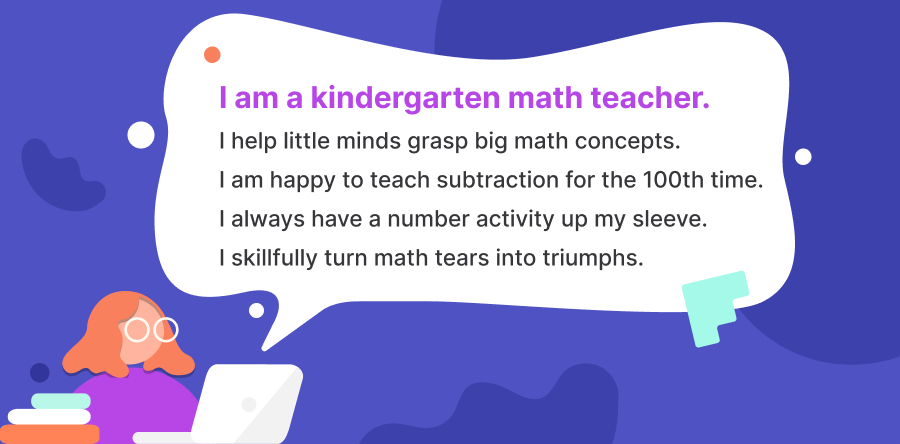
Preparing Kindergarteners for Grade 1 Math
Teaching math to kindergarteners mainly revolves around numbers and shapes. Understanding kindergarten math objectives is essential to ensure a smooth transition to the first grade. It will also help you plan lessons more effectively, manage your time efficiently, and determine appropriate teaching methods. Parents can use this knowledge to identify gaps and choose weak areas for kids’ home practice.
Here’s a Kindergarten math skills checklist to support your child’s learning:
- Counting and Cardinality
▢ Count by ones and tens to 100
▢ Count on from any number greater than 1
▢ Count objects and write numbers up to 20
▢ Understand one-to-one correspondence
▢ Represent numbers with numerals, pictures, and words
▢ Understand more and less concepts
- Addition and Subtraction
▢ Add and subtract within 10
▢ Solve addition and subtraction word problems within 10
▢ Achieve fluency with addition and subtraction within 5
Related Reading: What Do First Graders Learn: Overview, Subjects & Skills
Conclusion
So, let’s not underestimate Kindergarten level math! It is essentially planting the seeds of a lifelong love for numbers! At this age, students are still discovering their unique learning styles. Some might be quick at counting objects, while others might grasp concepts best through songs and rhymes. Every giggle during a counting game, every “aha!” moment with manipulatives—celebrate these tiny victories and watch them blossom into a love of learning. So, let’s make all math moments count! You’ve got this!
Related Reading: Math Activities for Kindergarten
Frequently Asked Questions (FAQs)
How can I make math centers fun for kindergarteners?
Incorporate games, songs, and hands-on activities like playdough shapes, sorting objects by shapes, grouping marbles as 10 and some more, or counting with snacks. The key is to relate math to their interests and daily life.
How can I ensure kindergarten students enjoy their math homework assignments?
The key is to keep it short, engaging, and connected to their world. Focus on the joy of discovery and exploration of math concepts rather than on formal assessment. For example, encourage counting practice by asking kids to count the number of family members, chairs, or stairs in the house.
How long should a kindergarten math lesson be?
Attention spans are typically shorter in kindergarten, so the ideal math lesson length should reflect that. Kindergarten math lessons should be brief, normally about 35 to 45 minutes. Do include math station activities in this duration.

















